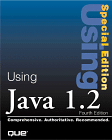A Good Source for Comprehensive Solutions
Good foundation, effective Java 1.2 coverage, looks at the Commerce and Media APIs, and inside the JVM.
ORIGINAL DRAFT
At over 1400 pages for under $40, "Special Edition Using Java 1.2" delivers a lot for the money. This book provides the kind of foundation you would expect from a practical book about using Java, and goes the extra mile with a look at advanced APIs like the Java Wallet and Media Framework, among others. There seems to be something in here for every kind of Java programmer, from beginner to expert. The Java 1.2 coverage is good, with chapters on the new Collections and 2D Graphics APIs, as well as the Swing and the Java Foundation Classes.
The content is divided into 11 major sections. Part I, "Introduction to Java", gives you what you need to get up and running with the JDK. Part II, "The Java Language", provides a complete Java tutorial, addressing issues ranging from object-oriented programming to managing applications, touching on data types, methods, classes, interfaces, threads and more along the way. Part III, "User Interface", spends 8 chapters talking about important UI solutions, including full chapters on components, events and exceptions, containers and layout managers, graphics, images and the 2D API, along with two chapters on the JFC (Java Foundation Classes).
Part IV, "IO", provides comprehensive coverage of files, streams, networking, serialization and protocols like TCP, UDP and RMI, with one of the chapter dedicated to internationalization. Part V tackles "Databases" in three chapters, two of which are dedicated to JDBC connections and exploration, respectively. These chapters could be improved with a few more examples, but the information is well presented and the examples seem sufficient to communicate the essential facts. Part VI, "Component-Based Development", looks at JavaBeans, CORBA and COM. Each of these are effectively introduced, but readers looking for in depth coverage will have to turn to dedicated books on each respective subject.
Some of the more interesting material is in Part VII, which covers "Advanced Java" concepts. The book explores the Java Media API, Java Commerce and the Java Wallet interface, the Collections API, and native programming, among other things. The coverage is necessarily limited but you’ll find enough information to evaluate these technologies and decide whether they are worthy of additional attention. Part VIII, digs into "Debugging Java", spread across three chapters that cover debugging your code, the Java class internals and the Java Virtual Machine itself. Part IX covers "JavaScript", especially useful if you’re working with Applets. Part X lists "Java Resources" and Part XI, the only "Appendix", covers what’s on the CD.
I personally found a lot of good information in this book, as I suspect even advanced Java developers should find. In particular, I found the chapters on Collections, 2D Graphics and Commerce APIs instructive. The Java Media Framework chapter and low-level class file and JVM coverage was interesting, as were the two JFC chapters. The writing is good and the content is accurate, with occasional screen shots and diagrams to help the reader visualize the presented solutions. All in all, my impressions were good, as is the overall value you’ll get from this book.
